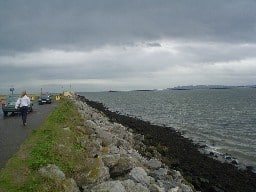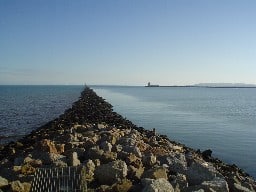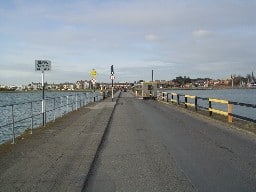The Bull Wall
Click On the Photos and Click again to return to the article
For centuries the shallowness of water and the existence of sandbanks at the entrance to Dublin Port were major hindrances to navigation to and from the Port. The sandbar at the mouth of the River Liffey posed a major problem with only 6 feet of water on the “bar” at low water. Indeed many lives, ships and cargoes were lost in Dublin Bay due to the sandbanks and inability of ships to cross the bar except at high tide. By the late 18th century this increasing volume of maritime trade and the emergence of larger ships made the problem critical.

While the Great South Wall was hailed as an engineering feat without parallel, the consequences were minimal in so far as deepening the river channels and the bar was concerned. At the turn of the 19th century eminent marine specialists were invited to submit proposals for the improvement of access to the Port.
A suggestion by Captain William Bligh in 1801 that a wall be built on the Northern bank of the river, parallel to the Great South Wall, was seriously considered by the Port Authority but eventually superseded by a broader plan. In fact, several of the proposal submitted envisaged a wall on the Northern side of the harbour to prevent the sands of the North Bull, then only a sandbank, from encroaching onto the Clontarf foreshore and also to concentrate the outflowing tide across the bar. It was expected that the resultant natural scour would deepen the river and its approaches without the assistance of any other works.
There was considerable disagreement as to the precise location and route of the wall. There was also a shortage of funds. Money was made available 19 years later when, following a new survey by Francis Giles, a joint report by Giles and the Port’s own Engineer, George Halpin, recommended the construction of what now is the North Bull Wall.
The wall was commenced in 1819 and completed in 1824. The materials used were granite and local limestone. It stretches for 9,000 feet from the shore at Dollymount to the North Bull light at the entrance to the Port. The 5,500 feet of wall at Dollymount to just beyond the Marian statue, the statue is called Our Lady Of The Port Of Dublin, erected in 1972, which remains above water at all stages of the tide.

The 3500 feet from the statue to the light, which is known as the half tide wall, is covered at high-water. The water drops below this section of the wall midway through the ebb tide so that for the latter half of each outgoing tide the water is forced between the 2 lighthouses ( North Wall & Poolbeg) at the entrance to the port.
The purpose of the half tide wall, and of the Bull bridge, is to act as safety valves to prevent damage to the wall from the pressure of full tide. The effect of tidal scour was that the force of the water cut a channel across the bar and deepened the previous depth of 6 feet to 16 feet at low water. The sand dislodged from the bar and was carried further out into the bay where it picked up by currents which then deposited it on the North Bull bank.


This was the beginning of the Bull Island which has grown steadily over the years from the sand and silt coming down the river, but which are now carried beyond their natural dropping point (the bar) and caught in the currents which carry them onto the island. The North Bull Lighthouse at the tip of the Bull Island was erected in 1880.
The Bull Island, with its 3.5 miles of beach, two golf courses and world famous bird sanctuary was thus created by the building of two great walls in the port. Clontarf an Overview
